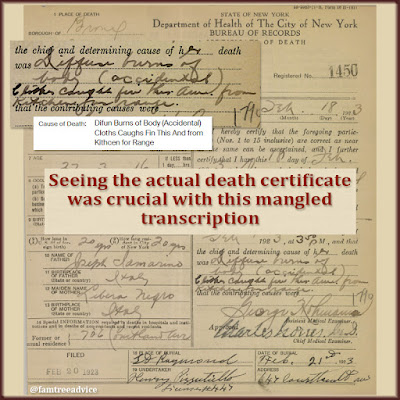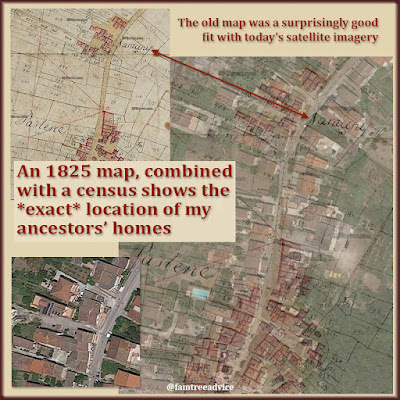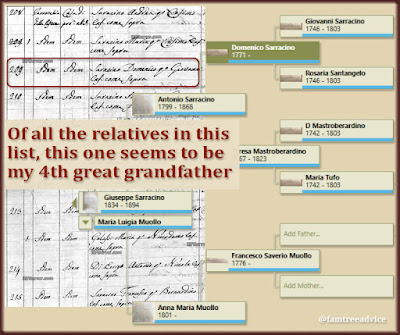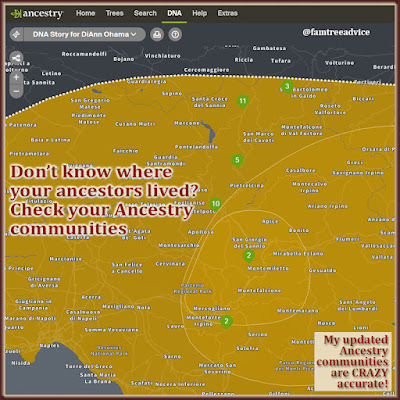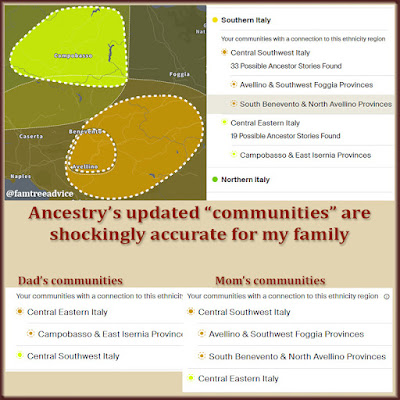My 1st cousin Nick tested with AncestryDNA and appears in my match list as my 1st cousin. He's in my mother's match list as her nephew—exactly as expected. My mother and Nick's mother are sisters.
But Nick found someone very unexpected in his DNA match list. My dad! Hearing this, I checked Dad's match list. There was my maternal cousin Nick, listed as Dad's 5th–8th cousin.
How on earth is my maternal-side cousin connected to my dad other than by marriage? I know Nick's paternal grandmother Carmela came from the same town as my paternal grandfather. There must be some connection in the town of Colle Sannita.
This has been a mystery for a few years now. I've done extensive research on Nick's paternal family tree. But I never found a blood relationship to my dad. I couldn't catch a break in solving this mystery.
Until now.
Two weeks ago, the NYC Municipal Archives put their vital records collection online (see 'How to Make Your Own Genealogy Correspondence Database' for the link). The majority of my relatives in America lived in New York City. So I had plenty of documents to gather.
As I worked through my NYC relatives, one document held a big surprise for me. It was the 1927 death record of Raffaele Cocca. Raffaele is Nick's great grandfather—the father of his paternal grandmother Carmela.
 |
| This newly available NYC death record rewrote my cousin's ancestry. |
The surprise on this death record was Raffaele's mother's name. I expected it to be Carmina, but it was Bellangela. We know death records can be unreliable because the informant may not know the right details. But I had to investigate.
I have all available vital records from Colle Sannita on my computer. I renamed the files to make them searchable (see 'Make Your Digital Genealogy Documents Searchable') by a person's name. Did I have a Bellangela Cocca in my records? I did, and she was the only person with this name. I had her marriage documents.
My mistake was instantly clear. It all came down to one wrong choice I made a long time ago. I had given Nick's grandmother Carmela the wrong father! Carmela's father (Nick's great grandfather) was not Giovanni Raffaele Cocca. He was Raffaele Luigi Cocca. That's who died in the Bronx in 1927. That's who was the son of Bellangela Cocca.
This correction completely altered the ancestry of Nick's grandmother Carmela. Could I find that mysterious DNA connection between Nick and Dad now?
Using the Relationship Calculator
One of my favorite features of Family Tree Maker is the Relationship Calculator tool. FTM shows the relationship of every person to the root person beneath their name. But sometimes there's more than one relationship. The Relationship Calculator spells out all possible relationships.
I used the calculator to see who had more than one relationship. I started with Nick and myself, but it showed only the expected 1st cousin relationship. Next I compared Nick's father to my father. Gasp! There were 2 relationships. It showed their brother-in-law relationship. But there was a 2nd, more complicated relationship.
 |
| FTM's Relationship Calculator, and especially the Relationship Chart, are crucial for understanding complex relationships. |
Granted, this doesn't sound like the relationship I was hoping to find. Nick's father is the 1st cousin 3 times removed (1C3R) of the wife of my father's 3rd great uncle. Clear as mud.
When you see a crazy relationship like that, you need a visual. Click the "View Relationship Chart" button in the Relationship Calculator. The chart helped me follow the path from Dad to my uncle. It showed me that:
- My father's 3rd great uncle was Onofrio diPaola, born in 1807.
- Onofrio's wife was Donata Viola, born in 1815.
- Donata's aunt, Carmina Serafina Marinaro, was the grandmother of Raffaele Luigi Cocca who died in 1927.
This still sounds like more of an in-law connection and not a blood relationship. But when I look at Onofrio and Donata in my family tree, things come into focus.
Onofrio is my 4th great uncle. And we've seen his wife Donata's relationship to Raffaele Luigi Cocca. That means Onofrio and Donata's children are cousins to Dad and me, and cousins to Nick and his father.
They illustrate the shared DNA that put Dad on Nick's match list. But they are not the answer.
Using Color-Coding to Visualize Connections
To visualize these family connections, I turned to Family Tree Maker's color-coding feature (see 'Using Color to Understand Your Family's Last Names'). I've been using colors to highlight my direct ancestors for a long time. I use four colors to tell me which of my grandparents is someone's descendant. I know that yellow=Pietro, magenta=Lucy, green=Adamo, and cyan=Mary.
I added a 5th color, orange, to Nick's father's (my uncle's) direct ancestors. Then I filtered my tree's index to show only my direct ancestors. I wanted to see if any of them now show orange. They do not.
Next, I made my way up to my uncle's earliest known ancestors from Colle Sannita. I color-coded all their descendants dark blue. No one—not a single one—was one of my direct ancestors.
What I did find was two blue or orange color-coded people who married a cousin of mine. One of these people was Donata Viola whose relationship I explained above. The other is Nick's 2nd great grandfather Giuseppe. His 1st wife was my 2C5R. But her children have no direct connection to my cousin Nick.
Then I noticed an unusual case: Maria Teresa Iacobaccio. She is a direct descendant of the same Marinaro ancestor as Donata Viola. She carries only the blue color-code, so she is not Nick's ancestor, but she is his 2C5R. Maria Teresa married the son of Nick's 4th great grandfather. All 6 of their children have the blue color-code, so they all have a connection to Nick's ancestors.
Here's the unusual part. Of Maria Teresa's 8 great grandparents:
- 6 are my 7th great grandparents
- 2 are Nick's 6th great grandparents
Without the color-coding, I may not have found this.
 |
| Some extra color-coding in FTM is the only way I was able to find the unusual case of Maria Teresa. |
Maria Teresa is not THE missing link between Nick and Dad because she isn't either one's ancestor. But she is a textbook case of how a long family history in one town can turn our DNA into a stew (see 'The DNA Problem We Aren't Talking About').
Drawing a Conclusion and Making a Plan
I've wondered for years what sort of relationship Nick and Dad have. The answer is: distant. They are, after all, a 5th–8th cousin match. They share only 11 cM, or less than 1% of their DNA. So it always made sense that if they shared a common ancestor, that person might be from the 1600s or earlier. Without access to church records, I can't document that type of relationship.
But I can document relatives who might pass along some of the common ancestor's DNA. With deep roots in one town, countless Colle Sannita descendants share some amount of DNA. Families in that southern Italian town intermarried for centuries. One person in my family tree had 36 different relationships to Nick's grandmother. Every single one of them was an in-law connection.
The unusual case of Maria Teresa Iacobaccio is the best I can do for now—but I'm not finished trying. I've been working on my genealogy masterpiece to connect EVERYONE from Colle Sannita in one family tree (see 'Why My Family Tree is Exploding in Size'). I may find fresh facts that point to a closer relationship between Nick and Dad.
With new color-coding in place, the next unusual connection won't get lost in the shuffle. Can this type of highlighting help you spot hidden relationships?

